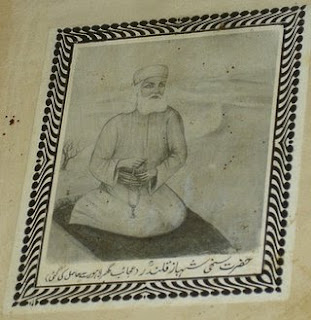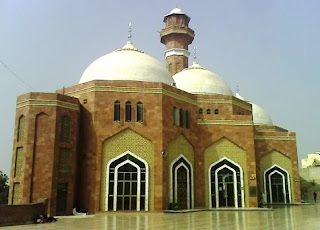Shah Nematollah Vali (or Nimatullah Wali) was born to a Sufi family in Aleppo, Syria. He travelled widely through the Muslim world, learning the philosophies of many masters, but not at first finding a personal teacher he could dedicate himself to. During this time, he also studied the writings of the great Sufi philosopher and mystic, Al Arabi.
Shah Nematollah finally met Shaykh Abdollah Yafe'i in Mecca, and became his disciple. He studied intensely with his teacher for seven years until, spritually transformed, he was sent out for a second round of travels, this time as a realized teacher.
He temporarily resided near Samarkand, along the great Central Asian Silk Road. It was here that he met the conqueror Tamerlane, but, to avoid conflict with the worldly ruler, he soon left and eventually settled in the Persian / Indian region of Kerman.
When Shah Nematollah died, his fame had spread throughout Persia and India, and it is said he initiated hundreds of thousands of followers. Today the Nimatullah Sufi Order is one of the most important Sufi orders of Iran.
Poems by Shah Nematollah Vali
Shah Nematollah finally met Shaykh Abdollah Yafe'i in Mecca, and became his disciple. He studied intensely with his teacher for seven years until, spritually transformed, he was sent out for a second round of travels, this time as a realized teacher.
He temporarily resided near Samarkand, along the great Central Asian Silk Road. It was here that he met the conqueror Tamerlane, but, to avoid conflict with the worldly ruler, he soon left and eventually settled in the Persian / Indian region of Kerman.
When Shah Nematollah died, his fame had spread throughout Persia and India, and it is said he initiated hundreds of thousands of followers. Today the Nimatullah Sufi Order is one of the most important Sufi orders of Iran.
Poems by Shah Nematollah Vali
I Beheld my essence. What i san
I beheld my essence. What I saw
Was like the very light of the eye itself:
How wonderful that a single Essence should
Refract itself like a light, a single source
Into a million essences and hues.
The being of the lover and Beloved
Are the same, for where is Love without
A lover and Beloved to be found?
Behold His Essence by His Light, that you
May be yourself the seer and the Seen.
I have wandered through the essences
And found that His Reality makes up
The essence of all beings. To ourselves
We manifest ourselves; were it not so
There could be no relationship between
The One and many. Now then, go beyond
Relation, go beyond the going-beyond
Till there remains no body, soul or being.
"All that is must perish save His face"
And in His Being ours is burned to ash.
At last I see that vision of Him requires
A subject and an object: I and He.
And yet the Essence is the same, sometimes
A wave upon the sea, sometimes the sea;
Sometimes the eye, sometimes the object of
The eye. Whoever sees this ocean knows
Our essence as we know it in ourself.
We are the waves and yet in essence we
Are not different from the sea: Reality
Is one but shows itself as two: subject
And object, two in manifestation
But not in Essence: only one Existence
Though countless its attributes. The mystery
Is still too deep for all to understand,
For all to grasp: the supraformal Essence
Is the Beloved and the formal self
The lover -- but if you switch the terms around
The statement still remains unchanged and true.
Or if you say the cup and wine are one
That too is true, as true as if you claim
That cup is cup and wine is wine; or if
You say that one is us, the other Him.
Regard these different levels of the truth
As "relatively absolute" and find
The subtle occult truth. Then... WA SALAAM!
The relativity of intellect
Results in statements which must contradict
Each other on the level of the mind
And yet beyond the mind both are correct.
Sometimes I am Mahmud, sometimes Ayaz
Sometimes I glorify myself, sometimes
I sing the other: lover and Beloved.
So from time to time I change and play
Both roles, and then a third one: Love itself.
Thus spoke Mustafa, beloved of God:
Go, search for the one who has enslaved your heart
Within your heart. There find the satisfaction
Of your soul at last. Seek Ne'matollah, find
All that you seek -- and all that you require
Will then be found in me, as you desire.
--------------------------------------------------------------------------------
The Point of the Circle
The point appeared in the circle And was not; But it was the dot That the circle begot. The point appears As a circle, as it revolves In the eyes of him Who a circle draws. When the point Completed the circle Its beginning and end Were one. When the compass Did the circle complete It was wrapped up And rested its feet. Without existence Not-being are we; We who are Not And You existence free. I said the whole world was His dream; Then I saw His dream was He. Sweeter than the words of our guide, Nimatullah knows no other words. The Sea Is Our Essence We are of the sea, and the sea is our essence; why then is there this duality between us? The world is an imaginary line before the sight; read well that line, for it was inscribed by us. Whatsoever we possess in both the worlds in reality, my friend, belongs to God. His love I keep secretly in my heart; the less of the pain of His love is our cure. Companions are we of the cup, comrades of the saki, lest thou suppose that he is apart from us: it is the assembly of love, and we are drunk -- who ever enjoyed so royal a party? So long as Mi'mat Allah is the slave of the Lord, the king of the world is a beggar at his door. |









